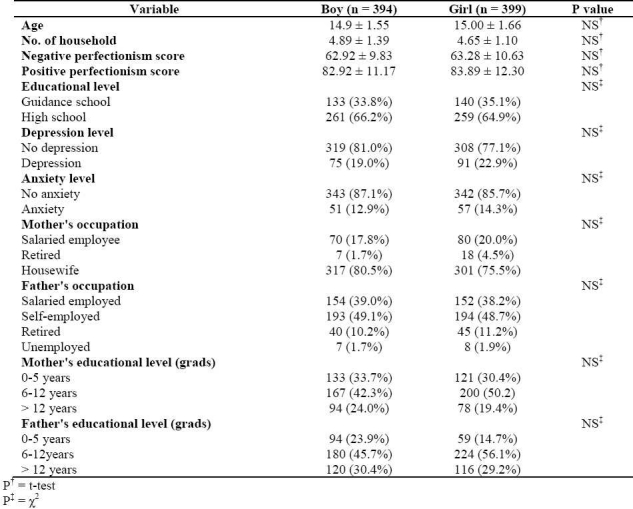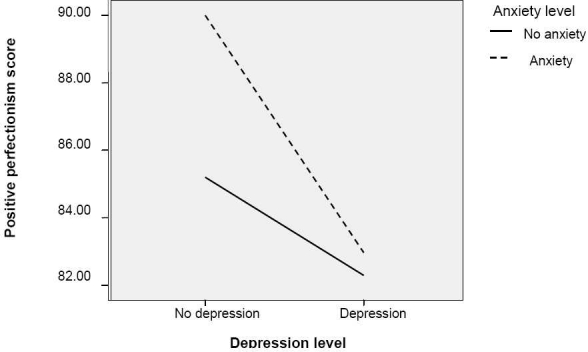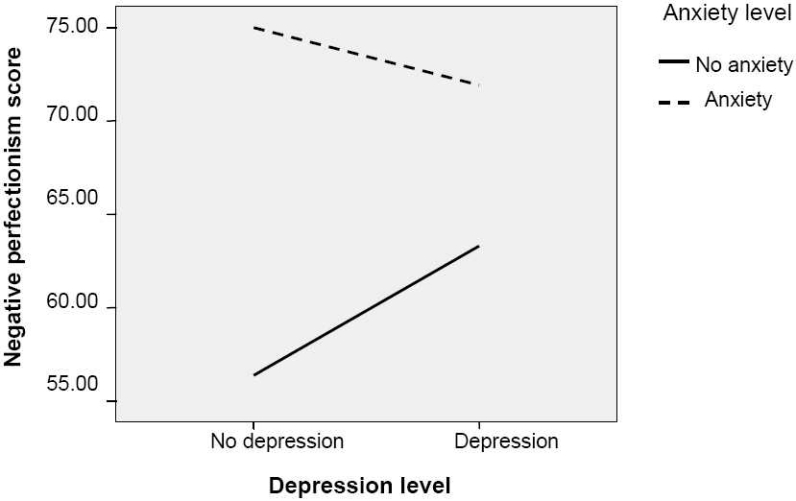Abstract
BACKGROUND:
Although many studies have investigated the relationship between perfectionism, anxiety, and depression among the adults, little is known about the manifestations of perfectionism among schoolage youths. This study has investigated this relationship in an Iranian sample.
METHODS:
Using multistage cluster random sampling, 793 Iranian school students in 2007 were studied. Data of demographic characteristics, children's depression inventory, revised children's manifest anxiety scale, and the positive and negative perfectionism scales were obtained using questionnaires.
RESULTS:
The results indicated that both aspects of perfectionism are associated with depression and anxiety. Negative and positive perfectionism have positive and negative associations, respectively, with depression and anxiety. The interaction of anxiety and depression with perfectionism reveals that depression is in association with lower scores of positive perfectionism, whereas in students with higher scores of negative perfectionism, the anxiety scores are also higher. Moreover, the accompaniment of anxiety with depression is in association with relatively lower levels of negative perfectionism.
CONCLUSIONS:
It was concluded that negative perfectionism is a risk factor for both depression and anxiety, while positive perfectionism is a protective factor. However, the interventions which encourage the positive aspects of perfectionism and decrease its negative aspects may be able to diminish psychopathological subsequence.
Keywords: Depressions, Anxiety
Perfectionism has been defined by Burns in 1980 as “…those whose standards are high beyond reach or reason, people who strain compulsively and unremittingly toward impossible goals and who measure their own worth entirely in terms of productivity and accomplishment. For these people, the effort for excellence is selfdefeating.1” A simpler definition has been offered by Horney as “the tyranny of the shoulds”, which makes the person to be highly critical of one's own behavior.2
It is usually emphasized that perfectionism is accompanied with negative feelings of failure, procrastination, and shame, due to its underlying psychopathology.3,4 However, perfectionism has some adaptive or healthy aspects, as it promotes striving for excellence. This type of perfectionism has been named as “normal perfectionism”. People who have high performance expectations and standards without being involved in negative selfappraisal are labeled as “normal” perfectionists,5,6 while those with high standards who are captured in negative self-appraisal, such as selfdoubt and worrying about making mistakes, are named as “neurotic” perfectionists.7 Negative perfectionists have unrealistic standards and goals, because of the this, their efforts usually fail, and finally lead to anxiety, depression and feeling inadequate.8
Generally, many studies had shown that negative perfectionists reported higher levels of psychological distress such as depression and anxiety, whereas positive perfectionists reported higher self-esteem than the other groups.9,10 Although much is known about the relationship between the both aspects of perfectionism with depression and anxiety separately, but a little is known about the interaction between these psychopathologies with perfectionism. The objective of the present study was to examine the cross-sectional relationships among negative and positive perfectionisms, depression, and anxiety in a school-students sample of both genders.
Methods
Participants
The study sample was collected from guidance (grades 6-8) and high (grades 9-12) schools students studying in private, public, and talented-students schools of the urban and rural areas of the Isfahan, in 2007. To stratify the study population multi stage cluster random sampling used according to gender, type of school (private, public, or talented-students schools) and number of students, according to the data from Isfahan Office of Education (based on educational districts). These data also included personal and academic data of students in all five educational districts of the city.
Approximately 5% of students were randomly selected from these clusters (systematic random sampling). The total number of students was determined according to their gender, and grade to the entire population of the students. In Iran, each of guidance and high schools has three grades. According to the calculated sample size for each gender, 395 students have been allocated and then have been distributed in to different grades.
Approvals were made with the ethical committee of the provincial University of Medical Sciences. All the students and their parents completed consent forms before participation. The students filled the questionnaires out during the class time, under supervision of their teachers.
Measures
The questionnaire included five parts: demographic characteristics, Children's Depression Inventory, The Positive and Negative Perfectionism Scale, Revised Children's Manifest Anxiety Scale and. Demographic characteristics included age, sex, number of the household, educational level of the child (primary vs. guidance school), father's job (unemployed, salaried employee, self-employed, or retired), mother's job (housewife, salaried employee, or retired), and educational level (0-5 years, 6-12 years, and > 12 years) of the parents.
Children's Depression Inventory (CDI)
The CDI is a 27-item self-report measure designed to assess cognitive, behavioural, and affective symptoms of depression.11 The CDI takes about 15 minutes to be filled out. Three statements with different severity (score 0-2) belong to each item of CDI, which students had to choose the best descriptions for themselves. A cut-off point of > 19 is typically used to identify depressed individuals.12 The CDI is the most widely used measure of depression in children, with good support for its reliability and validity.13
Revised Children's Manifest Anxiety Scale (RCMAS)
The RCMAS is a self-report measure revised by Reynolds and Richmond.14 The original questionnaire, the Children's Manifest Anxiety Scales (CMAS), is developed by Castaneda et al.15 The RCMAS consists of 28 items that as-sesses anxiety. The questionnaire gives a global score with yes/no answers and a cut-off point of > 19 is typically used to identify anxious individuals. The score ranges from 0 to 28 with higher scores indicating more anxiety. The questionnaire is reported to have acceptable reliability and validity.16
The Positive and Negative Perfectionism Scale (PNP)
The Positive and Negative Perfectionism (PNP) Scale assesses participant's perfectionism from functional or behavioural aspects.17
The answers of 40-Likert scale questions of PNP ranges from strongly disagree (= 1) to strongly agree (= 5); 18 questions are related to positive perfectionism and 22 questions represent negative perfectionism.
Cronbach's alphas for the positive and negative perfectionism scales have been reported as 0.89 and 0.86, respectively.18
Data Analysis
Continuous variables were presented as mean (one standard deviation), while qualitative variables were presented as absolute and relative frequencies. Differences between two groups were analyzed with t-test and chi square test.
A binary logistic regression analysis applying the entire procedure was then performed to independently find the association between the variables of perfectionism dimensions with depression and anxiety. The dependent variables were depression (yes/no) and anxiety (yes/no). The independent variables were negative and positive perfectionisms.
All analyses were conducted separately for both genders. P values were compared to a significance level of 5%. Data were analyzed using SPSS software (version 15.0).
Results
Boy and girl participants did not differ significantly in their demographic and family characteristics. These two groups also showed no significant difference in anxiety and depression levels and also negative and positive perfectionism scores (Table 1).
Table 1.
Characteristics of study population according to gender

Correlations between the two aspects of perfectionism and psychopathological measures (depression and anxiety) are showed in table 2. Negative perfectionism correlated significantly with depression and anxiety in both sexes, whereas positive perfectionism corre-lated inversely. As expected, negative perfectionism displayed the stronger correlation and the correlations for positive perfectionism were small.
Table 2.
Correlations of perfectionism dimensions, depression, and anxiety in both genders

Regression analysis was constructed to better determine to what extent negative and positive perfectionisms contributed uniquely to each of the psychopathological measures. These results are depicted in table 3. Binary logistic regression analysis showed that depression and anxiety are associated with higher scores of negative and lower scores of positive perfectionisms in both sexes. It means that in both sexes, negative perfectionism is a risk factor for depression and anxiety, whereas positive perfectionism is a protective factor for these two conditions. Also, these associations showed no significant differences, after age adjusting (Table 3).
Table 3.
Risk (odds ratios and 95% CI) for depression and anxiety by perfectionism dimensions in both sexes

Finally, the interactions of depression and anxiety with two aspects of perfectionism were explored. These analyses found the significant interaction of depression and anxiety with negative and positive perfectionism scores. The resulting graphs showed that the negative correlation between depression and positive perfectionism score was dependent on anxiety; it was more pronounced in students with anxiety than in students without it (Figure 1). Figure 2 showed that the correlation between depression and negative perfectionism score was dependent on anxiety, too; it was positive when the anxiety was present and was negative when the anxiety was absent (Figure 2).
Figure 1.

Interaction of depression and anxiety with positive perfectionism score
Figure 2.

Interaction of depression and anxiety with negative perfectionism score
Discussion
Findings of the present study show that both aspects of perfectionism -positive and negative- are associated with depression and anxiety scores in guidance and high school students. A positive association was found between negative perfectionism with depression and anxiety and a negative association was found between positive perfectionism with depression and anxiety. This means that in both sexes negative perfectionism is a risk factor for both depression and anxiety, while positive perfectionism is a protective factor.
In recent decade, some studies have demonstrated the association between perfectionism with anxiety and depression as Grzegorek et al and Chang et al compared adaptive and maladaptive perfectionism and demonstrated the maladaptive perfectionists had higher scores of depression and anxiety.9,19 Also, in a non-clinical student sample, Saboonchi et al have reported positive associations between expressions of anxiety and perfectionism.20
The results this study are in agreement with the mentioned studies, as negative perfectionism has positive associations with anxiety and depression and positive perfectionism has been showed as a protective factor in both sex-es. Gilman et al in 2005 and Kawamura et al in 2001 also found no significant difference between two sexes.21,22 The mechanisms of the relationship between perfectionism and these outcomes (depression and anxiety) are not well understood. After facing with failure, perfectionists experience more intense distresses than non perfectionists because of their needs to do tasks with perfect results and equation of their performance with their adequacy.23,24
The interaction of anxiety and depression with positive perfectionism is shown in figure 1. The main characteristic of these individuals is that they′re less exposed to depression, because the level of pursuit of excellence and success achievement are higher in them. However, because of higher level of motivation and striving, positive perfectionists experience higher level of anxiety. According to Saboonchi et al, continuing successes of positive perfectionists without avoidance of failure is associated with positive emotional feeling like pleasure, satisfaction and euphoria.20
Figure 2 shows the interaction of anxiety and depression with negative perfectionism. Subjects with higher scores of negative perfectionism experience more anxiety; this might be caused because of their excessive apprehension about others′ opinions. Indeed, unrealistically high standards and preoccupation with the failure increase their anxiety whereas owning high aims and standards (even unrealistic ones) causes lower level of hopelessness.
Being worry about rejection and lack of respect from others, cause daily stress for perfectionists, and these feelings lead to defensive interpersonal style which elicits actual negative reactions from other people. Multilevel modeling have shown that negative perfectionists have more emotional reactions toward stressors which cause to sense of failure, loss of control and criticism.25 Following that, they loss their motivation, encounter numbness or procrastination, and stop their striving.
This study has some limitations. The results of this study are relational and not causal, therefore, it can not be concluded from this study whether anxiety or depression are causes or results of perfectionism. The sample was restricted to students in Isfahan and this limits the results to be generalized, too. Also, compared with perfectionism, other personality dimensions might play important roles in predicting anxiety and depression. In addition, studying the parental pressure -from the students’ point of view- and parents’ expectations may help us to learn more about perfectionism and its related psychopathology.
Conclusions
The present study expands on researches which indicate that perfectionism is associated with depression and anxiety in school age students in both sexes. The present study also showed the interaction of depression and anxiety with two dimensions of perfectionism; it is revealed that depression is associated with lower scores for positive perfectionism, while students with higher scores of negative perfectionism, have higher scores of anxiety. With these results, better understanding of perfectionism and its positive and negative dimensions may be provided for students, parents, and even teachers. Also, it helps us to design an intervention to decrease negative perfectionism, and following psychopathology.
Conflict of Interests
Authors have no conflict of interests.
Authors’ Contributions
HA, HR and GA designed the study. AS, MeSa and HNI collected the data. AS and MaMo and MoMa analyzed the data. HR and MaSa wrote the manuscript. GA served as advisor for this research. All authors have read and approved the content of the manuscript.
Acknowledgments
This research was funded and supported by the Isfahan Behavioural Sciences Research Centre (Grant No. 389302). We would like to thank Dr. Jalil Shoahasani, Dr. Ahmad Abedi and Reza Jafariharandi, who helped us in conducting this study. We are also indebted to Hasti Roohafza for her kind cooperation in drafting this manuscript.
References
- 1.Burns DD. The perfectionist's script for self-defeat. Psychol Today. 1980;14:34–52. [Google Scholar]
- 2.Frost RO, Marten P, Lahart C, Rosenblate R. The dimensions of perfectionism. Cognit Ther Res. 1990;14(5):449–68. [Google Scholar]
- 3.Hamachek DE. Psychodynamics of normal and neurotic perfectionism. Psychology: A Journal of Human Behavior. 1978;15(1):27–33. [Google Scholar]
- 4.Hewitt PL, Flett GL. Perfectionism in the self and social contexts: conceptualization, assessment, and association with psychopathology. J Pers Soc Psychol. 1991;60(3):456–70. doi: 10.1037//0022-3514.60.3.456. [DOI] [PubMed] [Google Scholar]
- 5.Flett GL, Hewitt PL. Positive versus negative perfectionism in psychopathology: a comment on Slade and Owens's dual process model. Behav Modif. 2006;30(4):472–95. doi: 10.1177/0145445506288026. [DOI] [PubMed] [Google Scholar]
- 6.Bieling PJ, Israeli AL, Antony MM. Is perfectionism good, bad, or both? Examining models of the perfectionism construct. Pers Individ Dif. 2004;36(6):1373–85. [Google Scholar]
- 7.Saboonchi F, Lundh LG. Perfectionism, anger, somatic health, and positive affect. Pers Individ Dif. 2003;35(7):1585–99. [Google Scholar]
- 8.Dittner AJ, Rimes K, Thorpe S. Negative perfectionism increases the risk of fatigue following a period of stress. Psychol Health 2010 Feb. [Accessed 17 October 2010]. Available from: http://www.informaworld.com/10.1080/08870440903225892 . [DOI] [PubMed]
- 9.Grzegorek JL, Slaney RB, Franze S, Rice KG. Self-criticism, dependency, self-esteem, and grade point average satisfaction among clusters of perfectionists and nonperfectionists. J Couns Psychol. 2004;51(2):192–200. [Google Scholar]
- 10.Wang KT, Slaney RB, Rice KG. Perfectionism in Chinese university students from Taiwan: a study of psychological well-being and achievement motivation. Pers Individ Dif. 2007;42(7):1279–90. [Google Scholar]
- 11.Kovacs M. New York: Multi-Health Systems; 1992. Children's Depression Inventory (CDI) manual. [Google Scholar]
- 12.Masi G, Tomaiuolo F, Sbrana B, Poli P, Baracchini G, Pruneti CA, et al. Depressive symptoms and academic self image in adolescence. Psychopathology. 2001;34(2):57–61. doi: 10.1159/000049281. [DOI] [PubMed] [Google Scholar]
- 13.Abdollahian E, Yazdani Farabi Sh, Amiri Moghadam R. Prevalence of depression among primary school children in Mashhad. J Andisheh va Raftar. 2002;7(28):48–2. (Persian) [Google Scholar]
- 14.Reynolds CR, Richmond BO. What I think and feel: a revised measure of children's manifest anxiety. J Abnorm Child Psychol. 1978;6(2):271–80. doi: 10.1007/BF00919131. [DOI] [PubMed] [Google Scholar]
- 15.Castaneda A, McCandless BR, Palermo DS. Complex learning and performance as a function of anxiety in children and task difficulty. Child Dev. 1956;27(3):327–32. [PubMed] [Google Scholar]
- 16.Seligman LD, Ollendick TH, Langley AK, Baldacci HB. The utility of measures of child and adolescent anxiety: a meta-analytic review of the revised children's manifest anxiety scale, the state-trait anxiety inventory for children, and the child behaviour checklist. J Clin Child Adolesc Psychol. 2004;33(3):557–65. doi: 10.1207/s15374424jccp3303_13. [DOI] [PubMed] [Google Scholar]
- 17.Terry-Short LA, Owens RG, Slade PD, Dewey ME. Positive and negative perfectionism. Pers Individ Dif. 1995;18(5):663–8. [Google Scholar]
- 18.Besharat MA. Evaluating psychometric properties of Farsi version of the Positive and Negative Perfectionism Scale. Psychol Rep. 2005;97(1):33–42. doi: 10.2466/pr0.97.1.33-42. [DOI] [PubMed] [Google Scholar]
- 19.Chang EC, Zumberg KM, Sanna LJ, Girz LP, Kade AM, Shair SR, et al. Relationship between perfectionism and domains of worry in a college student population: considering the role of BIS/BAS motives. Pers Individ Dif. 2007;43(4):925–36. [Google Scholar]
- 20.Saboonchi F, Lundh LG. Perfectionism, self-consciousness and anxiety. Pers Individ Dif. 1997;22(6):921–8. [Google Scholar]
- 21.Gilman R, Ashby JS, Sverko D, Florell D, Varjas K. The relationship between perfectionism and multidimensional life satisfaction among Croatian and American youth. Pers Individ Dif. 2005;39(1):155–66. [Google Scholar]
- 22.Kawamura KY, Hunt SL, Frost RO, DiBartolo PM. Perfectionism, anxiety, and depression: are the relationships independent? Cognit Ther Res. 2001;25(3):291–301. [Google Scholar]
- 23.Hewitt PL, Flett GL, Ediger E. Perfectionism and depression: longitudinal assessment of a specific vulnerability hypothesis. J Abnorm Psychol. 1996;105(2):276–80. doi: 10.1037//0021-843x.105.2.276. [DOI] [PubMed] [Google Scholar]
- 24.Walsh JJ, Ugumba-Agwunobi G. Individual differences in statistics anxiety: the roles of perfectionism, procrastination and trait anxiety. Pers Individ Dif. 2002;33(2):239–51. [Google Scholar]
- 25.Dunkley DM, Zuroff DC, Blankstein KR. Self-critical perfectionism and daily affect: dispositional and situational influences on stress and coping. J Pers Soc Psychol. 2003;84(1):234–52. [PubMed] [Google Scholar]


